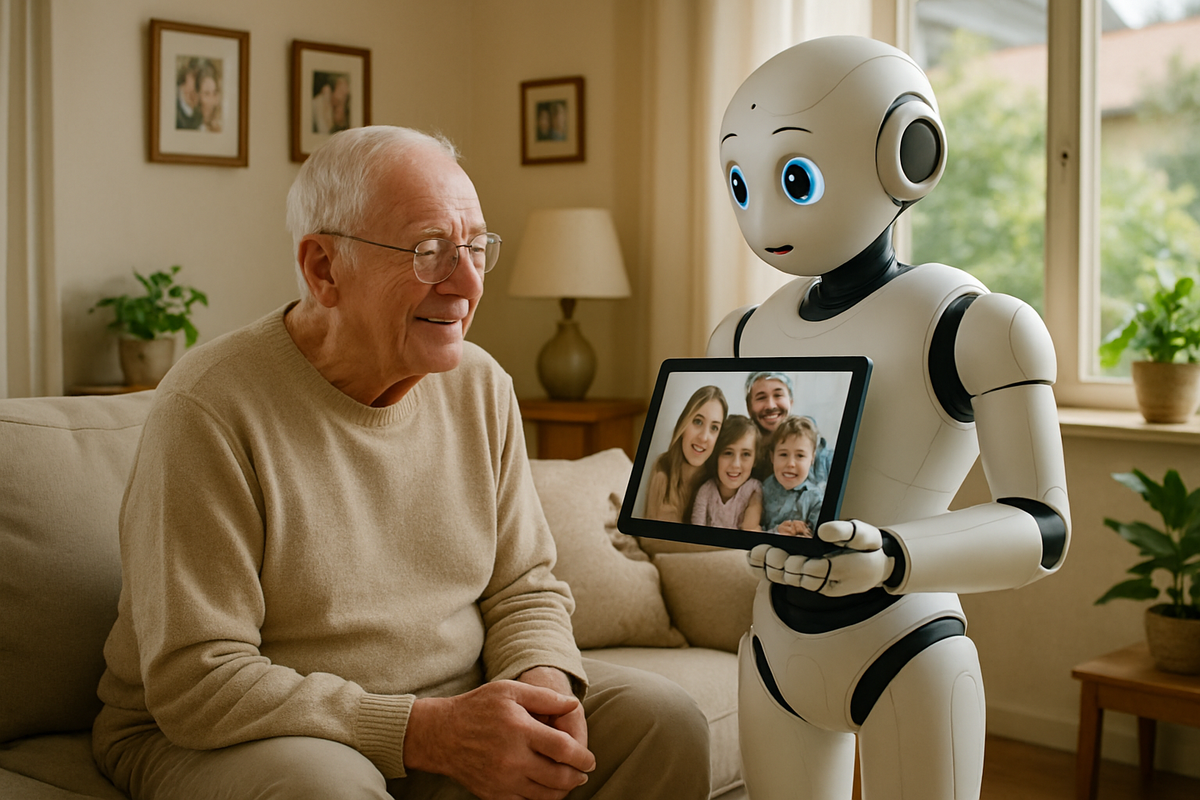AI-Powered Aging: How Robots Will Revolutionize Senior Living by 2035
By 2035, emotionally intelligent robots will revolutionize senior care, offering friendship, health monitoring, and independence—transforming from luxury gadgets to essential companions in an aging world. Discover how these charming bots change lives one beep at a time.

Welcome to the Age of Robo-Companions
Picture this: It’s 2035. You wake to the gentle greeting of your AI assistant, who’s already brewed your coffee, checked your health stats, and queued up your favorite 1970s playlist. No, you’re not living in a sci-fi reboot—this is the new normal for seniors worldwide.
Why the World Needs Robot Helpers—Yesterday
The world is aging at warp speed. By 2035, for the first time in history, people over 65 will outnumber children under 18 in the U.S., with similar shifts in Europe and Asia. Families are stretched thin, healthcare systems are buckling, and loneliness has been declared a public health epidemic. Enter: emotionally intelligent robots—ready to fill the gaps, one heartwarming beep at a time.
“The worst thing we do to prisoners is isolation. We send our parents into that state—not because we want to, but because that’s just how life is.”
— Dor Skuler, CEO, Intuition Robotics
From Sci-Fi to Sidekick: What Today’s Robots Can (and Can’t) Do
Forget the Hollywood humanoids of I, Robot. The real revolution is practical, affordable, and surprisingly charming. Today’s most successful home robots aren’t trying to replace nurses or out-dance Fred Astaire. Instead, they focus on:
- Companionship: Chatting, playing games, and reminding you to call the grandkids (or take your meds).
- Health Monitoring: Checking vitals, detecting falls, and nudging you to hydrate or stretch.
- Safety & Security: Watching the door, alerting caregivers, and keeping an eye out for mischief (looking at you, houseplants).
- Daily Assistance: Scheduling, shopping lists, and gentle prompts to move or eat.
Robots like ElliQ (a tabletop companion that combats loneliness) and Amazon’s Astro (a roving home assistant) are already making waves. Studies from pilot programs in New York show over 90% of seniors using ElliQ report reduced loneliness, better health outcomes, and—dare we say—more pep in their step.
The Next Decade: What’s Coming (and Why It Matters)
By 2035, expect robots to be:
- Emotionally Intelligent—reading tone, body language, and even mood to respond with empathy.
- Affordable & Accessible—no longer luxury gadgets, but essential tools for aging in place.
- Agentic & Proactive—anticipating needs, not just reacting to commands (think: suggesting a walk when you’re blue).
- Integrated with Smart Homes—seamless orchestration of lighting, security, and health devices.
- Privacy-First—with clear controls and ethical guardrails, so grandma’s secrets stay secret.
“We should build more R2-D2s and fewer C-3POs.”
— Dor Skuler, Intuition Robotics
Real-World Wins: How Robots Are Changing Lives—Today
Let’s talk impact, not hype:
- Loneliness-Busting: In pilot studies, seniors with robot companions reported lower rates of depression and increased medication adherence.
- Independence: Wearables and home bots detect falls, alert family, and help seniors stay in their homes longer—saving thousands in care costs.
- Caregiver Relief: Family members get peace of mind, knowing someone (or something) is keeping an eye out 24/7.
One memorable story: a 92-year-old in New York named Ruth, who started calling ElliQ her “roommate.” She credits her robot for reminding her to take her pills and, more importantly, for making her laugh daily. (Move over, Alexa—there’s a new BFF in town!)
How Robots Win Trust (and Hearts)
Let’s face it: inviting a robot into your home is a big step. The most successful bots earn trust by:
- Reliability: Like a fridge, they just work—no drama, no unexplained shutdowns.
- Transparency: Clear privacy settings, so you control what’s shared.
- Personality: Approachable, warm, and never uncanny. (Think R2-D2, not Terminator!)
- Inclusivity: Designed for all abilities, with accessible controls and voice options.
Pro tip: When shopping, look for devices backed by real-world studies and robust customer support. And remember, the best robots are those your loved ones actually want to spend time with.
What Families and Policymakers Need to Know
Robots won’t replace human care, but they’ll amplify it. For families stretched across cities (or continents), AI-powered assistants offer a safety net and a bridge for connection. For policymakers, investing in accessible home robotics is a win-win: healthier seniors, lower healthcare costs, and happier families.
Hot Tips for Getting Started
- Assess Needs: Is companionship, health monitoring, or security the top priority?
- Set Boundaries: Choose devices with strong privacy features.
- Involve Seniors: Let them test-drive options—they’ll know what feels friendly.
- Keep It Simple: The best robots are easy to use, update themselves, and play nicely with other smart home gadgets.
Bottom Line: The Future Is Friendly (and a Little Bit Adorable)
By 2035, AI-powered robots won’t just be gadgets—they’ll be beloved household members, trusted helpers, and champions for dignity and independence. The journey ahead is full of innovation, but the goal remains timeless: helping people live fuller, happier, and more connected lives at every age.
Want to stay ahead of the curve on smart aging, home robotics, and the future of caring tech? Subscribe for FREE to the Funaix Insider at this link for smart news and exclusive perks. Only subscribers can join our lively comments—don’t miss your chance to shape the conversation!
Published August 15, 2025 · All insights based on the latest market research, expert interviews, and real-world pilot programs.




